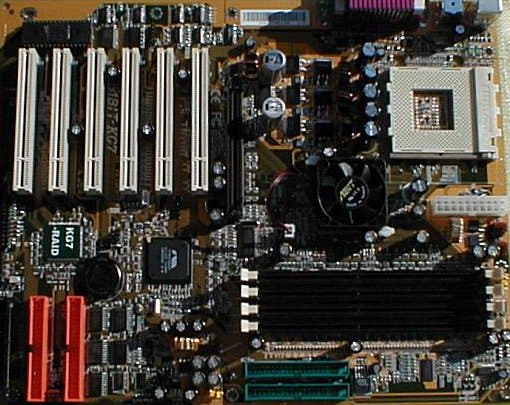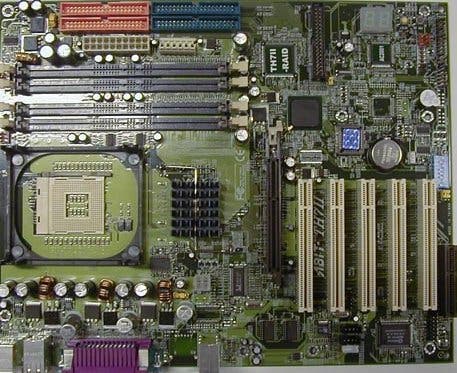ABIT's Autumn Bloomers
Article - Mugwum testdrives ABIT's latest motherboards for Athlon and Pentium 4 systems
ABIT's appearance in the UK on September 11th was marred by events that were completely out of the company's control, but its product range was diverse and intriguing nonetheless. In the immediate aftermath of the Roadshow we managed to get our hands on two of the company's latest top-end motherboards; the KG7-RAID, and the TH7II-RAID, for Athlon and Pentium 4 respectively.
Sweet Mother!
The KG7-RAID is based on the AMD761 chipset, and features four DIMM slots for DDR memory, support for all Durons and Athlons (including the new Athlon XP), an AGP4x slot and six PCI slots. In the box you receive a manual, some IDE cables, a CD containing drivers and documentation, and a floppy disk with essential drivers. The board features the usual two USB ports with an optional backplate and pins for a further two. The TH7II-RAID is based on the Intel i850 chipset, and as expected supports four sticks of RAMBUS RDRAM rather than DDR - the subject of much debate amongst Pentium 4 owners. The motherboard supports only the latest Socket 478 Pentium 4 processors, alienating owners of the original Socket 423 chips, and features an AGP4x slot, five PCI slots and an unusual three USB ports. Because of this abnormality (and the fact that many PC cases are too old to fit newer P4 motherboards), the box includes not only the usual manual, IDE cables and drivers, but also a backplate with space for the three tiered USB connector, and a motherboard backing plate for mounting the system upon to attach it to older cases. Both boards make use of the HighPoint 370 IDE RAID controller. This provides support for an additional four ATA100 devices, and is treated as an external device by the BIOS. In other words, you can boot to it by adjusting settings in the BIOS, but its settings are controlled by the HPT370 itself, which is accessed separately. RAIDers can opt for RAID 0 (striping), RAID 1 (mirroring) or RAID 0+1 (both - the safest and most expensive).

That's Why I'm Easy
Both boards are installed and used fairly painlessly. Both are also fairly large, so you should make sure that all the cables are tucked neatly away so you don't end up snagging them, but a few screws are nothing to worry about. Pentium 4 owners would do well to remember that the usual ATX power supply has to be complemented by the smaller ATX 12V power connector. If you are upgrading to Pentium 4, check your PSU for a small square connector that you don't presently use. If this is missing you may need to buy a new power supply. Pentium 4 owners will also need to remember a specific RAM configuration. RAMBUS RDRAM has to be used in pairs, like old fashioned SIMM memory in a way. So if you use two sticks of 64Mb and two sticks of 128Mb, remember to group them together, with the highest value in DIMM slots one and two. In the case of the KG7-RAID there is little out of the ordinary to be concerned with. You may want to download the latest VIA Service Pack (version 4.33) when you are up and running though, particularly if you use Windows XP. The VIA 686B south bridge chip, used on the KG7-RAID to complement the AMD761 north bridge chip, was in the press a lot recently because of problems with PCI timing. Apparently, if you transferred files from one ATA100 hard disk to another on separate chains you could run into difficulties, and a SoundBlaster Live! would accentuate the problem. We have noticed no such issue with the KG7-RAID, presumably because the engineers at ABIT have provided a BIOS capable of dealing with the issue. Another well-publicized 'problem' was the CPU protection facility. If the speed of the fan connected to header one fell below a certain number of RPM, the machine would be powered off to save the processor, with the unfortunate side effect being that people who used molex (four pin) fans connected directly to the PSU had to plug something in to fan header one to make their machine go. This feature is now optional, rather than obligatory.

The Competitive Edge
In terms of performance compared to rival boards, there is nothing to choose between, so when it comes down to deciding to buy ABIT over ASUS or Microstar, the choice is almost entirely down to the BIOS. People can get by with five PCI slots instead of six, or three DIMM slots instead of four, but the thing that sets boards apart is the BIOS. In ABIT's case, Softmenu III is the showpiece. Included on both boards, this features options for adjusting the CPU speed through front side bus and multiplier (the latter on KG7-RAID only), as well as CPU and I/O voltages and RAM timings. Companies like ASUS have struggled to compete with Softmenu III and continue to do so. The ASUS board that could be directly compared to KG7-RAID for instance is the A7M266. This board uses more or less the same configuration, although is features only two DIMM slots and only five PCI slots. Multiplier adjustment is non-existent on the ASUS board though, and front side bus adjustment is flaky at best. On the ABIT board, a failed overclock can be undone by holding down a particular key during bootup. In ASUS' case it involves resetting the BIOS, meaning continual physical access to the machine. RAM timings are covered in incredible depth on the two ABIT motherboards as well. You can overclock individual timings or use a preset performance value. Overclocking memory can be just as beneficial as overclocking the processor, and ABIT recognize this.
Conclusions
As we commented at the ABIT Roadshow, none of the new "ABIT Engeineered" features appear on the KG7-RAID. CPU voltage tweaking does not go beyond 1.85 volts as ABIT promised it would, and there are no overclocking strips to disperse electromagnetic interference buildup. Moreover there is no digital display that monitors system conditions. This appears on the TH7II-RAID, but not the KG7-RAID. A disappointment, to be sure. In both cases the pricing is going to be the main issue. There was a time when a decent motherboard could be had for close to £100. The KG7-RAID retails for closer to £150 and the TH7II-RAID £185. In the former's case, that's more expensive than the processor you are likely to buy for it. The market is moving that way though - the KG7-RAID is no more expensive than its competitors, and the TH7II-RAID has scant few competitors on the Socket 478 front anyway. We have no qualms about recommending the TH7II-RAID to our readers. It's a sturdy, well-documented and supported motherboard with lots of options for expansion, and it utilizes the latest Socket 478 Pentium 4 processors. Intel may do away with Socket 478 in the future as they are doing with Socket 423, but there isn't much to be done about that, and if you plan to build a new system based around a Pentium 4 processor this should be taken into consideration. You would certainly not - as far as performance is concerned - be better off buying the cheaper BL7-RAID and using SDRAM. The KG7-RAID we have more difficulty in recommending. While it is true that it could be deemed 'best of class' as far as AMD761 motherboards are concerned, its successor the KR7-RAID (based on the VIA KT266 chipset) looms on the horizon, along with the NV7, which is based on NVIDIA's nFORCE. Many feel that the KR7-RAID in particular will be a superior board in terms of overclocking and like-for-like performance. If you need an Athlon motherboard using DDR RAM now though, the KG7-RAID is it. It has more DIMM slots and a superior BIOS compared to its competitors.
-

